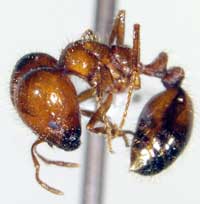Characteristics:
- Major worker ants have relatively large heads compared to body
- Body 1/16 to 1/8 in length
- Have two distinct sizes of workers (dimorphic)
- Major workers (soldiers)
- Minor workers
- Have 12-segmented antennae with 3-segmented club
- Coloration: reddish-brown
- Feed on live and dead insects, seeds and honeydew
- Have 2 nodes in the pedicel (petiole and post petiole)
The worker caste is dimorphic (two different sizes). They range in size from 2.4-3.8 mm long. The head of the major worker (largest) is very large in proportion to the body and is bi-lobed with a medium furrow. Antennae have twelve segments ending with a distinct 3-segmented club. The thorax has two spines on the epinotum. New colonies are formed by mating flights that typically occur during the summer. Multiple queens may group together and bring forth a new colony, but a single queen eventually dominates and kills the other queens.
Distribution
The big-headed ant, Pheidole dentata (Mayr) is a native species of Pheidole commonly found in the southern United States. It ranges from Kansas to Virginia and south to Florida. They nest in exposed soil, under objects on the ground, in rotting wood, and tree stumps and in piles of debris on the ground. This is the most common species of Pheidole in the southern states. Pheidole dentata (Mayr) primarily lives outdoors, and only occasionally is an invader of structures. They commonly nest in the soil around structures, and as conditions change, chronic infestations involving these ants may be encountered. Natural foods of this ant consist of live and dead insects, seeds and honeydew. In the home they feed on meats, grease, liver, fruit juices and peanut butter. They may prefer high protein foods.
Management
Determine where the ant colonies are located and then treat them directly with an appropriate insecticide. Small ant colonies around buildings, along the foundations and under objects can be drenched with a liquid insecticide using a small hand sprayer. Make a thorough inspection and determine where ants cannot be treated directly and use toxic baits in these areas. Treatments around building foundations with a spray application of an appropriate insecticide will prevent outdoor foraging ants from entering buildings. Inside structures, colonies of ants located inside wall voids should be treated with an appropriate dust insecticide formulation. These should be injected directly into cracks and crevices and other entry holes using a compressed air sprayer. Indoor baiting can be effective and also the safest method. Ant baits are available in child-resistant containers. Liquid baits and granular baits can be used safely and effectively when they are injected into wall voids, in hidden areas in.